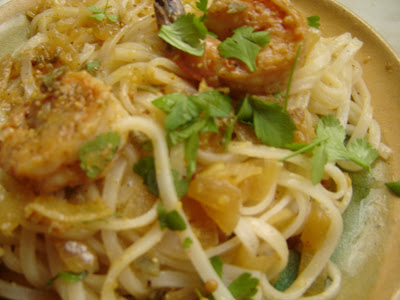An absolute move over to the gluten-free camp has yet to be achieved. However, a baby step or two has been taken. I've been buying Quinoa, corn or rice pastas, and have now made up my own AP flour mix, the one recommended by Shauna, the Gluten-Free Girl, with a 70% whole grain flour to a 30% starch ratio. My present one being composed of corn flour, brown rice flour, sorghum and teff, with the starch end made up of potato, tapioca and white rice.
I would like to say that these muffins are an unqualified success, but.... not completely happy. They are good, with a fine light texture, and needing only a tad more definition. Some graininess. Oat bran might do it. Does that make sense? It might be I need to try another mix. One with fewer components. Maybe only whole wheat spelt (which has a small amount of gluten) sorghum and quinoa for the flour side and just the tapioca or white rice on the starch side. Of course, then I wouldn't be able to call them gluten-free. But, it's not like I'm allergic, just that using less gluten is helping joint and arthritis symptoms. And, experimenting is enjoyable. Just call me a food scientist.
But the crepes I made with the mix on Sunday morning were great. It totally worked, giving them a nice nutty character. You don't necessarily want the texture of grain in your crepes. More on these later.
These fruity muffins use the same clever principle as those Blue Blueberry Muffins I posted about a few years back. The ones from Joanne Fluke's tasty escapade, the Blueberry Muffin Murder. Nothing like a good murder mystery with recipes included. What a fun series of books she's written. So, the concept is to add some compote or pie filling in addition to your fresh or frozen fruit, for an extra zap of the flavor. However, that is where the muffin connection ends. Shauna's are gluten-free, of course, it goes without saying. And not so sweet as the Blueberry ones.
I would like to say that these muffins are an unqualified success, but.... not completely happy. They are good, with a fine light texture, and needing only a tad more definition. Some graininess. Oat bran might do it. Does that make sense? It might be I need to try another mix. One with fewer components. Maybe only whole wheat spelt (which has a small amount of gluten) sorghum and quinoa for the flour side and just the tapioca or white rice on the starch side. Of course, then I wouldn't be able to call them gluten-free. But, it's not like I'm allergic, just that using less gluten is helping joint and arthritis symptoms. And, experimenting is enjoyable. Just call me a food scientist.
But the crepes I made with the mix on Sunday morning were great. It totally worked, giving them a nice nutty character. You don't necessarily want the texture of grain in your crepes. More on these later.
These fruity muffins use the same clever principle as those Blue Blueberry Muffins I posted about a few years back. The ones from Joanne Fluke's tasty escapade, the Blueberry Muffin Murder. Nothing like a good murder mystery with recipes included. What a fun series of books she's written. So, the concept is to add some compote or pie filling in addition to your fresh or frozen fruit, for an extra zap of the flavor. However, that is where the muffin connection ends. Shauna's are gluten-free, of course, it goes without saying. And not so sweet as the Blueberry ones.




















